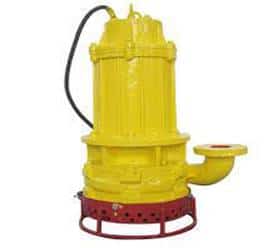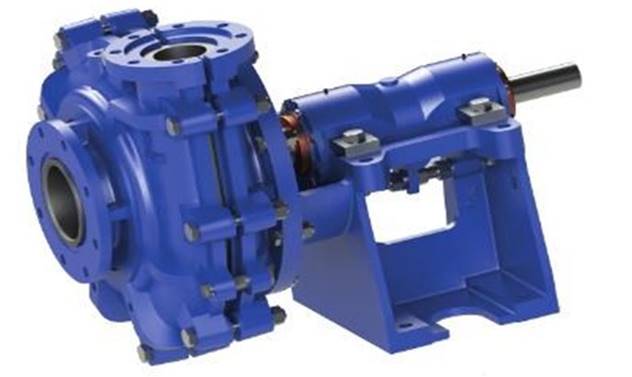Slurry Pump
What is a slurry pump?
A slurry pump is a pump manufactured for pumping liquid that has solid particles as well as solvents, alcohols, petroleum, or acids. Slurry pumps are prone to wear and thus their design needs to make them robust compared to other pumps. Slurry pumps are driven by electric motor or by hydraulics. Slurry pump manufacturers produce them in a way that makes them strong enough to withstand wear as they work on heavy-duty construction by adding large shafts, impeller diameter, internal dimensions, and bearings.
How does a slurry pump work?
A slurry pump works by converting kinetic energy from the motor shaft to induce flow by raising fluid pressure which makes the fluid start rotating after entering the pump. This process makes the media gain pressure and velocity as it exits the impeller. In the pump, there is a diffuser that decelerates the media flow which then increases the pressure in the flow. This makes both the kinetic energy and pressure of the media being pumped increase as it leaves the impeller. This energy is responsible for transporting the fluid or media to the required destination.
Components of slurry pump
Impeller
The impeller of the slurry pump can be made of materials such as an elastomer, high-chrome, or stainless steel. The impeller is a rotating component that has vanes that are responsible for imparting centrifugal force to the media being pumped.
Casing
It is made up of a cast that has wear liners to enhance high operating pressure. The shape of the casing is semi-volute or concentric with efficiencies less than that of volute casing.
Shaft and bearing
The shaft is of large diameter with a short overhang to reduce vibration and deflection. The bearings used are heavy-duty roller bearings that are housed in a detachable bearing cartridge.
Shaft sleeve
The shaft sleeve is a heavy-duty, hard, and corrosion-resistant sleeve that has O-ring seals at the ends to protect the shaft.
Shaft seal
The shaft seal for the slurry pump could be mechanical, packing seal, or drive seal.
Drive
The drive type for the slurry pump could be fluid coupling, V-belt, frequency conversion device, or gear reducer drive.
Slurry pump Types
Slurry pumps are of several types. The most common types of slurry pumps are centrifugal slurry pumps and positive displacement slurry pumps.
- Centrifugal slurry pump
Centrifugal slurry pumps are pumps that can transport high capacity at a limited head. Centrifugal slurry pumps are commonly used to pump slurry via pipes with a concentration of less than 70% solids based on weight. Centrifugal slurry pumps could be of submersible, horizontal or vertical type.
Submersible centrifugal slurry pump
A submersible centrifugal slurry pump is a pump that works while submerged in a fluid. It is capable of handling abrasive slurries. The submersible centrifugal slurry pump has entry at pump suction which helps to increase the slurry speed by use of vanes on rotating impeller. The vanes rotation action creates a centrifugal force that is responsible for conveying the slurry via the casing to the discharge. The casing part is horn-shaped and it helps to transfer speed into pressure.
The performance of a submersible centrifugal slurry pump is defined by the impeller and casing design. The efficiency is determined by among others the vanes design and number of impeller vanes. Because of handling slurries, submersible centrifugal slurry pumps can have their efficiencies altered by clearances and thus the need for building pump components that are resistant to abrasion, taking into consideration thickness of the materials among others. A submersible centrifugal slurry pump is either driven by electric motor or by hydraulics. If it is driven by electric motor, the impeller is carried by the motor shaft while for the hydraulically driven case, the motor is connected directly to the main pump shaft.

Figure 1: Submersible centrifugal slurry pump.
Horizontal centrifugal slurry pumps
Horizontal centrifugal slurry pumps are pumps that have their wear parts made of rubber or hard metal. They are large in size, powerful, and provide high capacity relative to vertical centrifugal slurry pumps. The centrifugal horizontal slurry pump is a reliable pump for transporting silt, ore, and ash in metallurgy, coal, construction, mining among others.
The horizontal centrifugal slurry pump is powered by a motor via pulley belts and impeller. Slurry gets into the pump through feed ort and it gets out through impeller action.

Figure 2: Horizontal centrifugal slurry pump.
Vertical centrifugal slurry pump
Vertical centrifugal slurry pumps are pumps that need lesser space compared to horizontal centrifugal slurry pumps. They are available in rubber or hard metal material. Vertical centrifugal slurry pumps use an auxiliary impeller that helps reduce impeller back pressure and give more life to the seal. Vertical slurry pump manufacturers produce the pump in a way that makes it to have lightweight and make it easy to install. Vertical centrifugal slurry pumps are used mainly to pump ore slurry, mortar, mud, and other similar media that contain suspended solid particles.

Figure 3: Vertical centrifugal slurry pump.
Positive displacement slurry pumps
Positive displacement slurry pumps are pumps that can transport high heads at a limited capacity. They are used to pump slurry via pipes with high solids concentrations. Positive displacement slurry pumps operate differently from centrifugal slurry pumps. Positive displacement slurry pumps use reciprocating or rotating parts to transport the media being pumped. The design of positive displacement slurry pumps produces pressure that produces energy to drive the media to the desired destination. However, positive displacement slurry pumps pump liquids at a slower rate compared to centrifugal pumps.

Figure 4: Section view of positive displacement slurry pump.
Advantages of slurry pump
- Slurry pumps are designed to have high efficiency, reasonable cooling, reasonable lubrication, and low working temperature.
- The slurry pumps have their flow parts strong to resist wear, they have a long working life, and their maintenance interval is less thus saving costs for repair.
- Slurry pump bearing box layout is reasonable, sealing is good and thus leakage of fluid is not easy.
- Slurry pumps run smoothly, thus they have low vibration, and have a large adjustment flow range.
- Slurry pump flow parts are designed reasonably to enhance easier disassembly, reduce consumption and energy-saving capabilities.
Disadvantages of slurry pump
- Slurry pumps get subjected to intense shock loads and shaft whip which can make its life short.
- Slurry pump construction needs thick material, unlike other pumps which makes it a bit expensive.
- Slurry pump speed should be according to the slurry type (abrasion classification) otherwise its life will be short.
Slurry pump application
Slurry pumps are used in different industries such as mining, drainage, agriculture, mineral processing, and dredging. For example, slurry pumps are used to transport solids in mining industries such as coal, copper, phosphate among others. Slurry pumps are also used to clean waterways in gravel and sand, and also in alumina and phosphoric acids.
Slurry pump troubleshooting
The slurry pump cannot start
Sometimes the slurry pump cannot start due to some reasons such as very tight packing, debris has jammed the impeller, embroidered bearings and pump shaft, or the pump shaft has a bent. When this problem occurs, then the power supply needs to be checked, and loosen water diversion tank and packing, disassemble and clean rust and debris, and correct the shaft.
The slurry pump is not absorbing water
The slurry pump not absorbing water could be due to several reasons which are there is intake of air in the suction piping system, there is air in the slurry pump, or there is an intake of air in the shaft seal. For such problems, the solution is to add some exhaust measures to improve sealing performance and enhance water pressure and water volume at the seal of the shaft.
Overheating of bearings
Bearing overheat in slurry pumps could occur due to several reasons such as pump shaft and motor shafts are not concentric, plastic pad on the coupling is damaged, oil enters slurry chamber or oil has some dirt.
Noise and vibration
Slurry pumps could develop noise and vibration due to damaged bearings, blocked impeller or pipeline, an insufficient supply of slurry leading to pump evacuation. When this happens the solution is to replace bearings, increase the supply of slurry, close the pump outlet valve, and adjust pump characteristics so that they match those of the pipeline.
Overheating of the motor
Motor overheating in a slurry pump could be due to lower high voltage, the motor having been overloaded for a long term or improper connection of the motor.
The solution to this problem can be solved by adjusting the voltage, limiting the number of starts, correctly selecting thermal protection, using the motor as per the upper calibration rating, checking to ensure the motor is connected properly.
Summary
This article has discussed slurry pumps. Slurry pumps are pumps that are used in different industries to pump liquid that has solid particles and which may contain solvents and acids or petroleum. Three mainly two types of slurry pumps that is the centrifugal slurry pump and positive displacement slurry pump. These two types can be driven using electricity or by use of hydraulics. The centrifugal slurry pumps are also classified further into submersible slurry pumps, horizontal slurry pumps, and vertical slurry pumps.
Slurry pumps like other electro-mechanical devices do develop technical problems such as motor overheating, noise and vibration, bearings overheating, and failing to restart. However, these problems can easily be sorted out by following the manufacturer’s guides or by consulting a pump expert.
